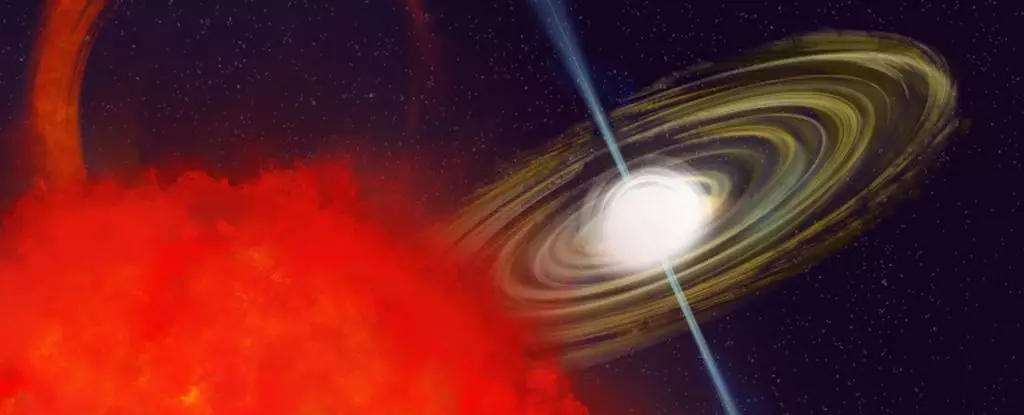In the vast tapestry of our universe, transient cosmic phenomena continually challenge our understanding of celestial physics. Among these, a newly identified object, CHIME J1634+44, stands out as an extraordinary anomaly. Unlike typical astrophysical entities that fade into obscurity or behave predictably, this object defies conventional classification through its bizarre pulsating behavior, rapid spin-up, and unprecedented polarization signals. Its discovery doesn’t just add another piece to the cosmic puzzle; it demands a fundamental rethinking of what we know about compact stellar remnants and their interactions with surrounding matter.
What makes CHIME J1634+44 so compelling is its combination of long, mysterious cycles intertwined with rapid internal dynamics. This is not a fleeting flash or a random flicker but a long-period transient showcasing a complex choreography that has so far eluded explanation. Its signals, brightening and dimming over timescales extending hundreds or even thousands of seconds, hint at an intricate dance of gravitational and electromagnetic forces. These features suggest a rare, possibly singular, class of celestial objects that could reshape our understanding of how stars end their lives and interact with companions.
Deciphering the Enigma: A Binary System in Dispute
The core of the controversy surrounding CHIME J1634+44 revolves around its true nature. Astrophysicists are wrestling with whether it is a white dwarf with extraordinary behaviors or a neutron star exhibiting unprecedented activity. Both scenarios have compelling evidence, yet both also raise significant questions.
On one hand, the detection of a faint ultraviolet source matching this object hints at a white dwarf, with estimates lining it up as a relatively modest star—approximately 78% of the Sun’s mass. White dwarfs, the remnants of stars like our Sun, are known for their stability, yet some, known as white dwarf pulsars, defy the rule by emitting periodic radio signals similar to their neutron star cousins. If CHIME J1634+44 is indeed a white dwarf pulsar, it would represent an exceptionally rare breed, challenging established notions of stellar evolution and magnetic activity in compact stars.
Alternatively, the high polarization of the radio waves suggests a different narrative. The degree of polarization observed is extraordinary, indicative of a highly ordered, possibly complex magnetic environment. This level of polarization, especially being perfectly circular—a phenomenon never documented in long-period transients—points more convincingly toward a neutron star, particularly a pulsar. Neutron stars, with their intense magnetic fields and rapid rotations, are notorious for their electromagnetic prowess, often emitting beams of radio waves that sweep across space like cosmic lighthouse signals.
The ongoing debate underscores the profundity of the mystery. If the object is a neutron star, its increasing spin rate could be caused by matter accretion from a close companion. Such ‘spin-up’ phenomena are fascinating because they showcase the dynamic, sometimes violent, processes governing stellar remnants. Conversely, if it is a white dwarf, then its behavior suggests an entirely different mechanism—possibly related to accretion-induced magnetic interactions—that remains largely unexplored.
The Implications of a New Class of Stellar Objects
What if CHIME J1634+44 isn’t just another curious object but the prototype of a new class of astrophysical phenomena? Its dual periodicities—a fast cycle of either 14 minutes or 841 seconds, alongside a secondary period of about 70 minutes—are unlike any known stellar remnant. This could imply a system with an orbiting companion or an internal oscillation mode that challenges our current models of stellar mechanics.
Furthermore, the remarkable polarization signals prompt us to reconsider the origin of such emission. Circular polarization suggests a highly ordered magnetic field configuration, possibly more complex than those observed in known pulsars or white dwarfs. If the radio emissions are produced through entirely novel processes—perhaps involving relativistic plasma near the object or exotic magnetic reconnections—they could open a window into physics beyond our current theories.
The broader impact of understanding CHIME J1634+44 extends beyond mere classification. It could redefine our knowledge of stellar evolution, especially the late stages involving mass transfer, magnetic field evolution, and angular momentum dynamics. Moreover, this object might serve as a bridge to understanding extreme environments like magnetars or even entirely new categories of celestial bodies previously confined to theoretical speculation.
Future Observations: The Key to Unlocking Its Secrets
The path forward hinges on detailed, multi-wavelength observations and theoretical modeling. Confirming the nature of CHIME J1634+44 demands not only more radio data but also optical, ultraviolet, and X-ray monitoring to identify its potential companions and internal processes. High-resolution imaging and spectral analysis may reveal telltale signatures—such as accretion disks, magnetic field structures, or secondary companions—that could tilt the scales toward one hypothesis.
Importantly, detecting more such objects could revolutionize the landscape of astrophysics. As more long-period transients with unusual polarization and periodicities are uncovered, patterns may emerge that link them together, hinting at a hidden diversity of stellar remnants lurking in our galaxy. This discovery serves as a clarion call for astronomers to broaden their search parameters and refine their models.
In contemplating the cosmic significance of CHIME J1634+44, it becomes evident that the universe continues to surprise us—pushing the boundaries of scientific understanding and challenging our assumptions about the life cycles of stars. Whether a white dwarf or a neutron star, this object embodies the mysteries that fuel scientific curiosity and the quest for knowledge. Its revelation underscores that even in well-charted realms like stellar remnants, there remain unexplored territories teeming with untold phenomena just waiting to be illuminated.


Leave a Reply